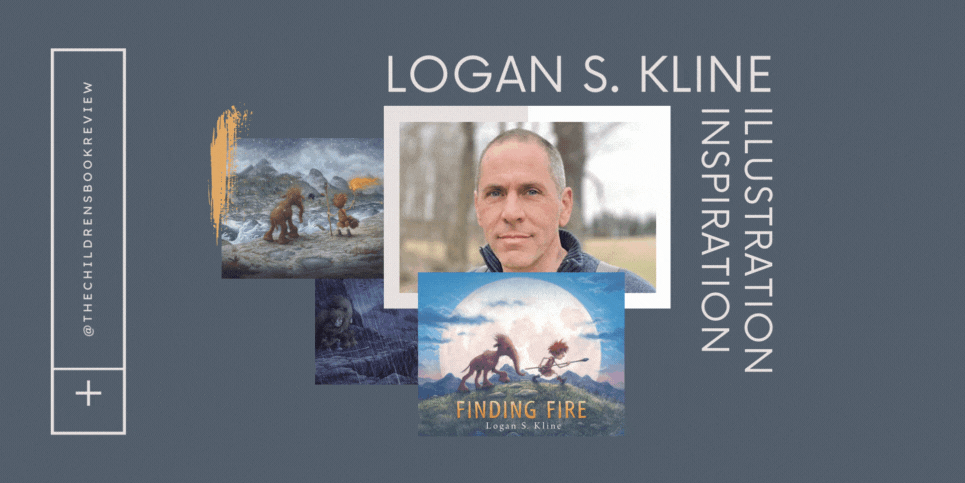An Illustration Inspiration interview with Logan S. Kline, Creator of Finding Fire
The Children’s Book Review
It’s safe to say that Logan S. Kline lives and breathes art! His work has appeared in several magazines, including Highlights, Ladybug, and Cricket. He is also a high school art teacher (lucky teens!) and is now a picture book creator.
Kline’s exquisitely illustrated, almost wordless picture book, Finding Fire, was released to much acclaim. We’re thrilled for this behind-the-scenes look into his process, what inspires him, and his most used art supply. Read on!
I make art because …
It’s a condition… I’m thoroughly convinced that it is a condition. I know a lot of individuals that are good at it, and enjoy it, and even find meaning in the making and pursuit of it. But for me, it’s like sunlight in the winter…I’m just drawn to it.
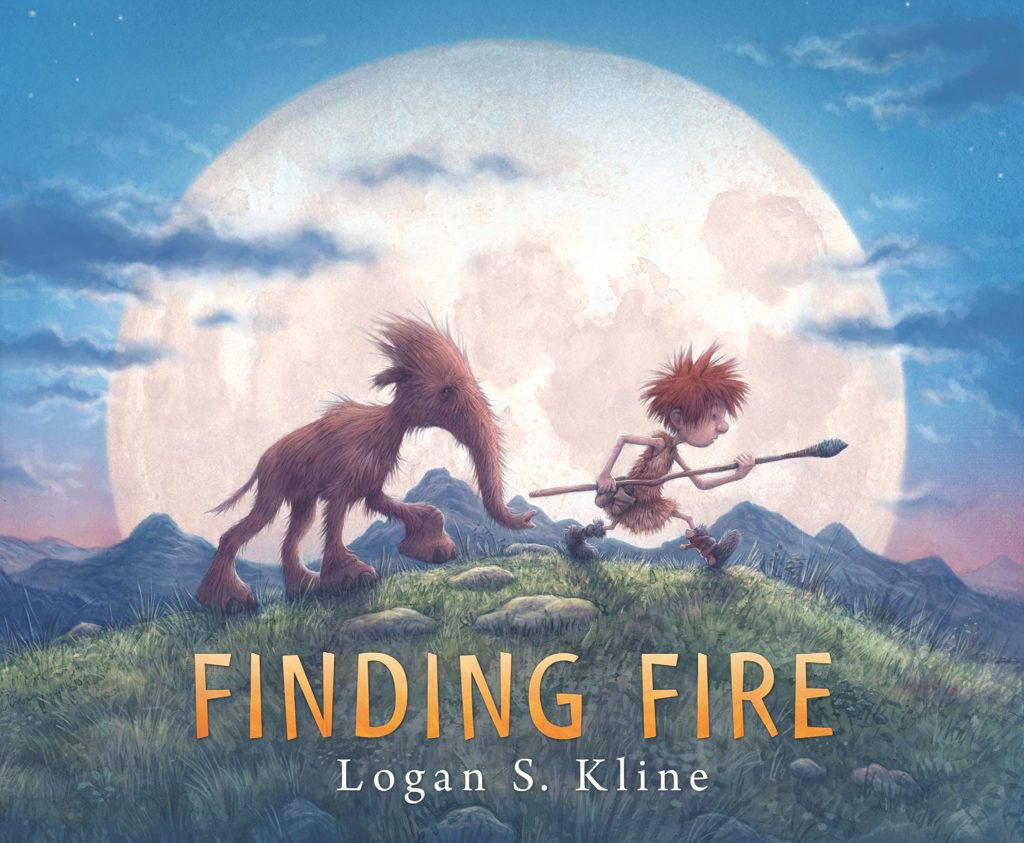
My latest published book is …
Finding Fire, a nearly wordless picture book in 40 pages published by Candlewick Press.
I’m very proud of it and people seem to be responding to it, especially kids. The story takes place during a time when humans used fire but had not yet discovered a way to make fire. Instead, they relied on naturally occurring forest or brush fires. Anthropologists refer to this as harvesting fire. Once harvested, the trick was to never let it go out. Finding Fire begins with a large storm, a flooded cave, a smothered fire, and one brave child.
Art medium used …
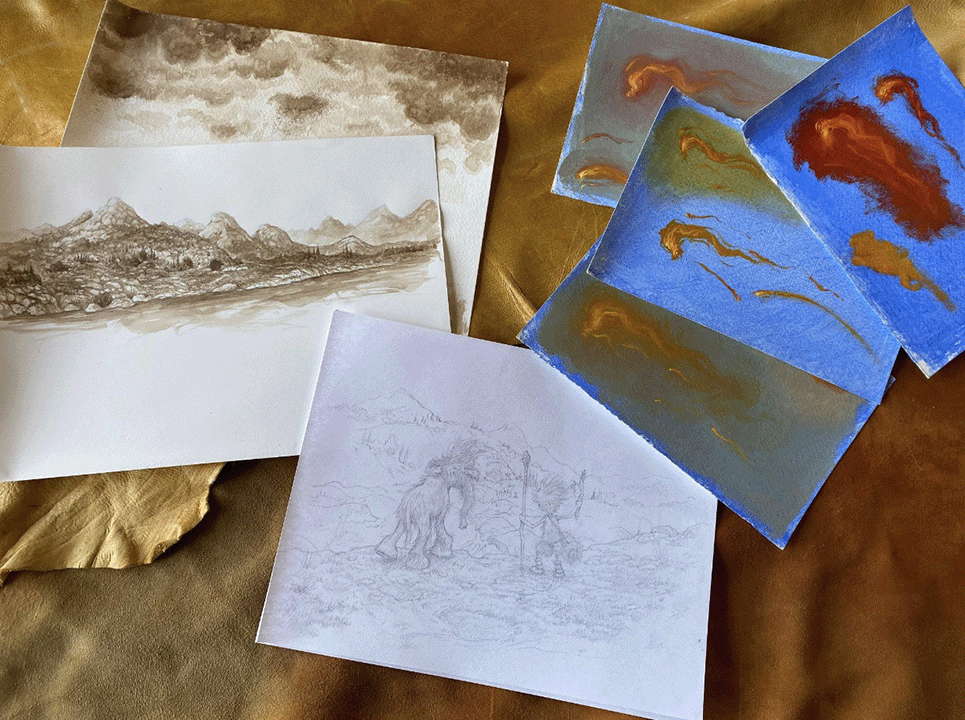
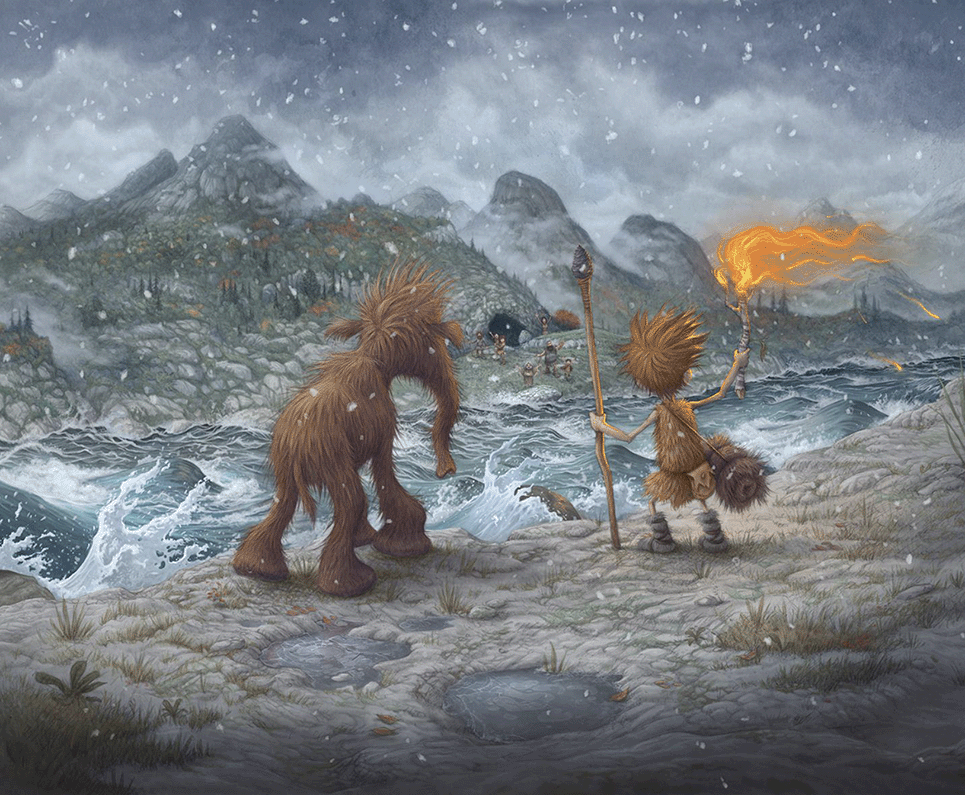
I’ve done everything from welding to animation but the current process that I’m using for my illustrations…suits me the best. It’s a fusion of graphite, ink, a little oil, and a lot of digital techniques. I never expected to be a digital artist. I was trained traditionally with oil paint on canvas and charcoal and Conté crayon on paper, as well as india ink and watercolor. I would obsess over the works of Velasquez, Inges, Vermeer, and Rembrandt, even the contemporary works of Odd Nerdrum (not for kids, by the way), and just dream of making something that was on par with these artists but you can’t control chemistry.
The digital process allows me to deviate from the most obvious path and experiment without destroying the progress I’ve made. This is very satisfying to me because I don’t like to walk away from a project until I feel I’ve explored every possible avenue.
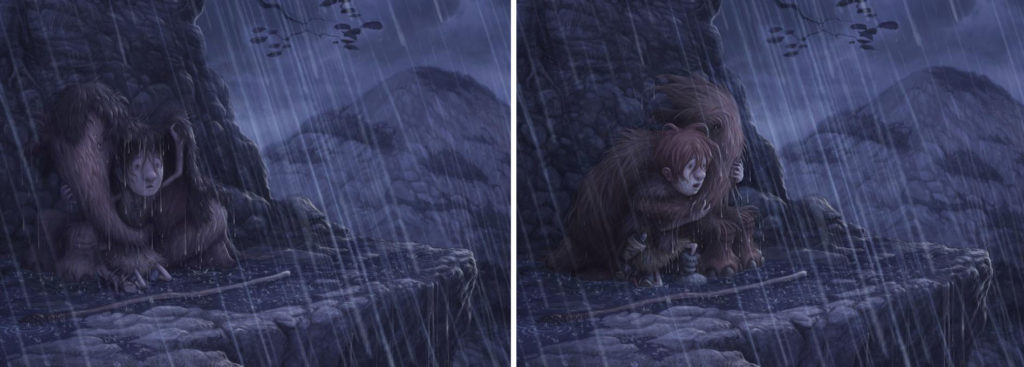
To that point, you can see the details above showing two versions of pages 24 & 25. It was a critical moment in the book for the two characters who are at their most desperate. I wanted to show them huddled together in a way that clearly demonstrated that these two are bonded as friends. I loved my first concept, which had the boy using his fur blanket to give them both shelter from the storm. This looked great in the earliest stages but as I added shading and color, it became harder to see…some folks even thought the boy was pulling the mammoth’s fur over his head (yikes).
The second version communicated much more quickly and effectively…you felt their bond as soon as you saw them. The digital process I use builds everything on separate layers so the boy and the mammoth (originally drawn in graphite) are rendered separately from the background (originally painted with ink). This allowed me to remove the original version of the boy and the mammoth and replace it with a version that told the story much better. It was about two weeks of work, but it could have been much longer.
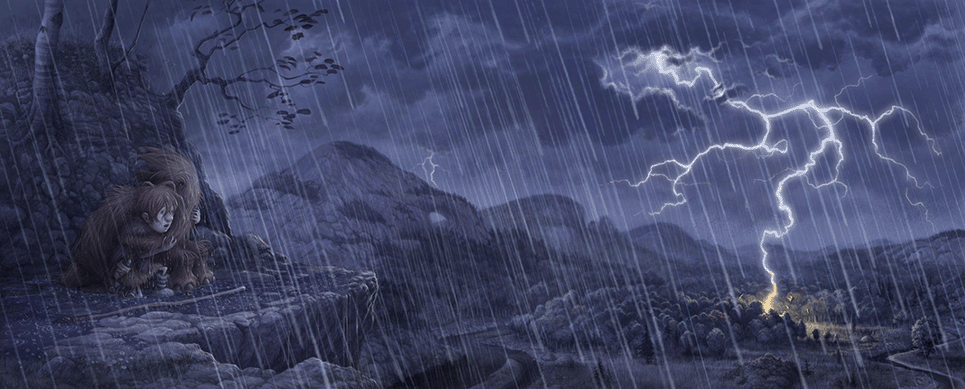
Artistic process …

Typically it starts with a graphite drawing, made up of mostly light outlines and strategically placed cross-hatching. This drawing is then scanned at the highest resolution I can manage. After that, there are a lot of digital techniques that are completed almost exclusively in Adobe Photoshop. The amount of layers I utilize is fairly extreme. My art director at Candlewick found my Photoshop files unusable (a fact that I devilishly take delight in). The detail you see above is from a file that is 11.68 gigabytes…for some unhealthy reason, I take pride in that.
I am inspired by …
Everything…I notice strange details and tend to overthink everything. Anything from childhood memories, how my son’s hair manages to shoot out all over the place, the way an older man might lift furniture into a truck bed, nightmares and daydreams, art I’ve seen in magazines and in person, the way my youngest son’s forearm flexes when he’s on the rings, books I cherish, drives in the country, the way my wife’s lower lip looks when she’s concentrating, the mood created by heavy fog, and the list just goes on and on and on.
As an illustrator or, more broadly speaking, a storyteller, my job is to connect with other people in a way that is (at least) interesting…the best way I know how to do this is by noticing and depicting our shared experiences with some level of artful reverence. Taking notice of the little moments in life, as well as the big meaningful ones, is critical to sharing a compelling story with others.
My favorite place to create and illustrate is …
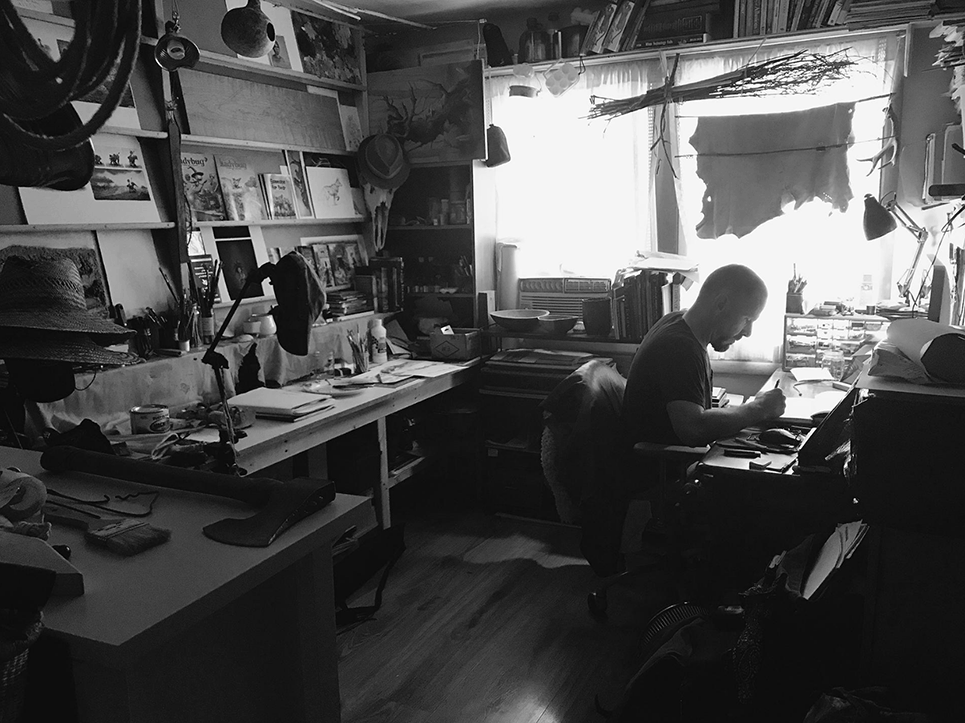
I pride myself on being able to work anywhere. For instance, I did a lot of the work on Finding Fire while waiting for my youngest child to finish gymnastics practice (three-hour practices, four days a week). That said, a quiet place with very few distractions is best. My studio is in my home and I’d say my most productive moments are from 11 PM to 1 AM. Finding Fire was an intense five years of work (2 ½ years developing the dummy book with my agent and 2 ½ years creating the final art) and during the school year I did most of my work between 6 PM and 3 AM.
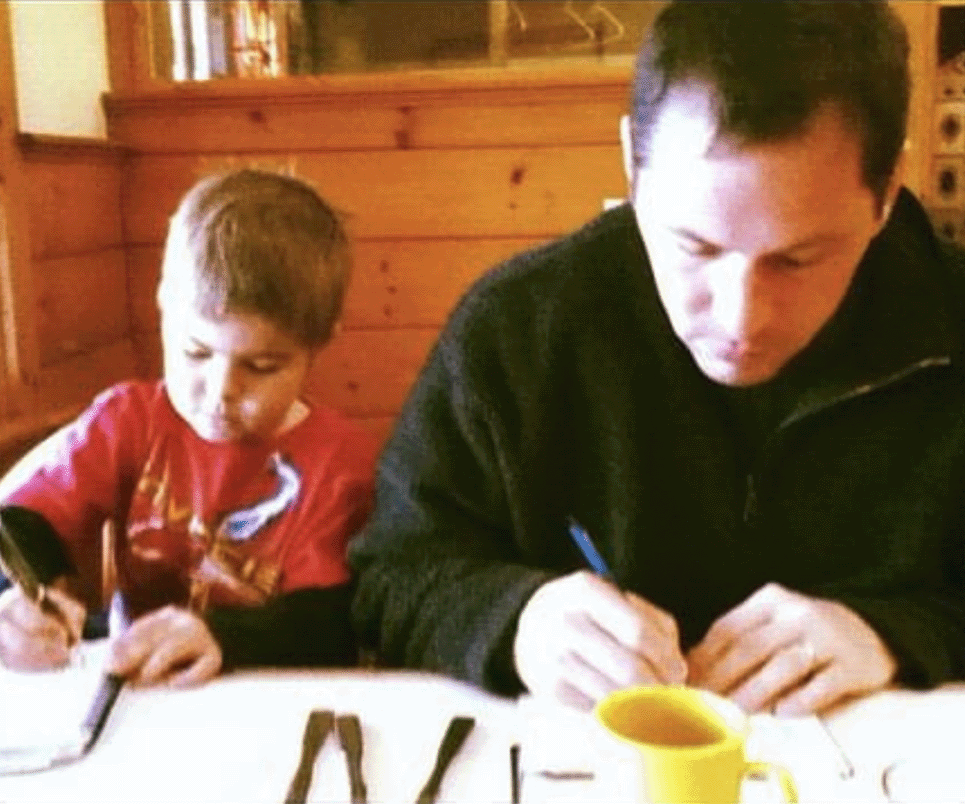
My most used art supply or tool is …
Mechanical pencil, 0.3 size lead.
Illustrator idols …
I grew up with Frank Frazetta and Norman Rockwell and I still love them to this day. But currently, I connect more deeply with picture-book makers. It was the picture book The Frog Prince Continued, illustrated by Steve Johnson, that caught my attention as a teenager and put the idea of being a picture book illustrator in my head.
My reverence for the art form was solidified by the many beautifully told stories of Chris Van Allsburg. David Weisner created stories that dealt with the full potential of the picture book format; the way his version of The Three Pigs breaks the fourth wall and acknowledges the reader not just as an observer but as a potential participant in the storytelling is mesmerizing and deeply intelligent. The Journey series by Aaron Becker has been an absolute beacon of honest, joy-filled storytelling for me; I love them.
All-time favorite children’s book I didn’t illustrate…
The Wild Girl by Chris Wormell, it’s nearly perfect and it’s an absolute delight to read with children. It also taught me about the power of page turns. There’s a great moment where a bear enters a cave occupied by a little girl. My two boys physically moved back from the book as I turned to this page and revealed that the hulking form outside the cave was indeed a giant bear. They would ask me to read The Wild Girl to them even when they were old enough to read it themselves. I will love that book forever.
A literary character to create art with …
This is a tricky question. I’m fairly particular when it comes to artmaking, which would test an individual’s patience and resolve. I also tend to stay up way too late making art, so they would need to be a serious night owl.
I’d say it would have to be one of Professor Tolkien’s elves. Why, because they would have a deep understanding of how long it takes to make something beautiful, they live forever, so they wouldn’t feel like they were wasting their life discussing the finer nuances of a particular illustration with me, and they do not need as much sleep as most humans do. So yeah, I’d have to say Galadriel from the Lord of the Rings…I’d make art with Galadriel.
Currently working on …
I have four stories that I’m mulling over. One is about a Neanderthal girl who just might change the world; the other is a modern-day Sasquatch child who does not follow the rules, the third is about a monarch butterfly whose white wings are not the only unusual thing about it, and the fourth is a secret… (only my wife and two sons know about this one).
To learn more, visit www.loganskline.com.
About the Book

Finding Fire
Written and Illustrated by Logan S. Kline
Ages 4+ | 40 Pages
Publisher: Candlewick | ISBN-13: 9781536213027
Publisher’s Book Summary: Can a young boy find fire for his family—and bring it safely home? An exciting, nearly wordless picture book adventure as visually compelling as a Pixar short.
After a hard rain douses the family fire, a brave young boy sets out to search for more fire to bring home before the cold season sets in. Along the way, he’ll face many challenges, from perilous mountains to fearsome predators to raging rivers, and find something wholly unexpected: a friend.
In his picture book debut, artist Logan S. Kline crafts a dramatic tale inspired by prehistoric times and told almost entirely through stunningly detailed illustrations. “Finding Fire started with the sketch of a small boy holding a torch and grew from there,” he says. “A lot of research went into creating the art for this book, yet the look of the boy changed very little over time as he was inspired by my children, from my younger son’s wiry frame to my elder son’s wild hair that goes in a million different directions.” This gorgeous adventure story just begs to be visited again and again, with each perusal promising new discoveries.
Buy the Book
Discover more illustration inspiration and books like Finding Fire, created by Logan S. Kline, on The Children’s Book Review by following along with our Illustration Inspiration series and articles tagged with Acceptance, Friendship, Illness, Jarvis, Kindness, and Picture Book.

